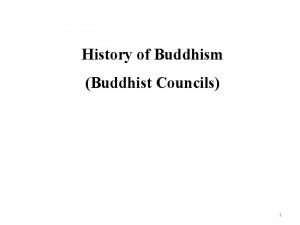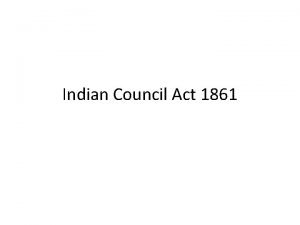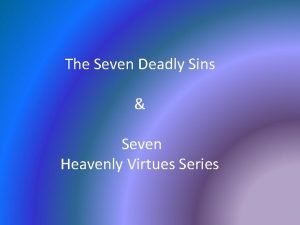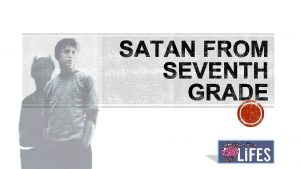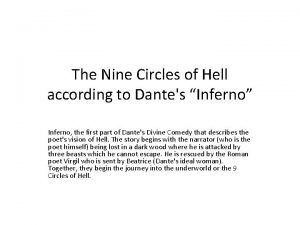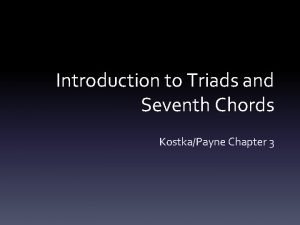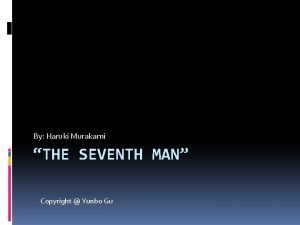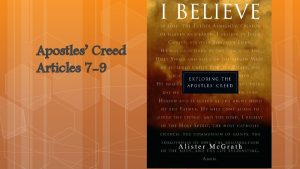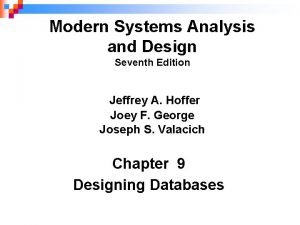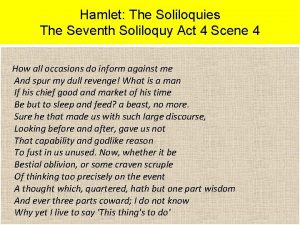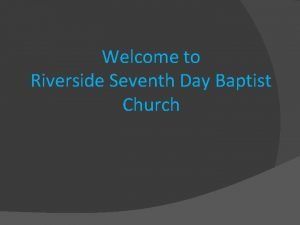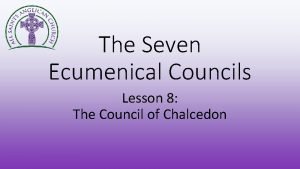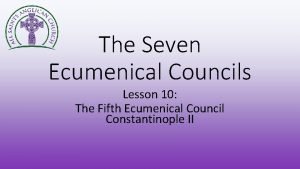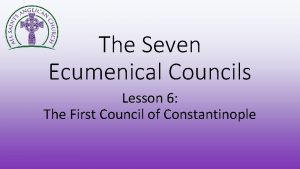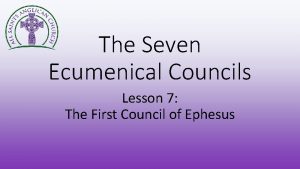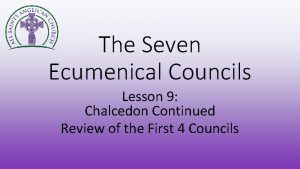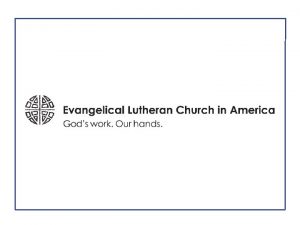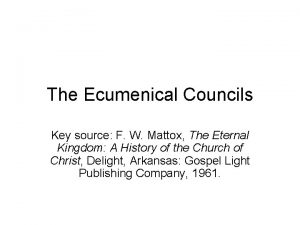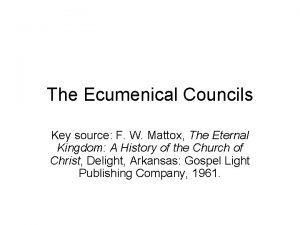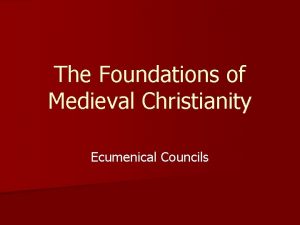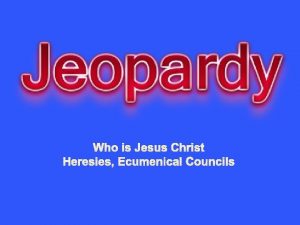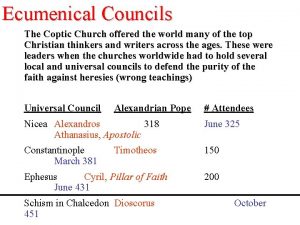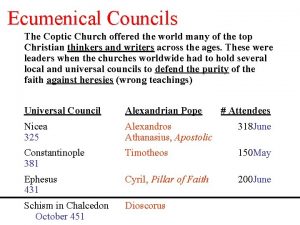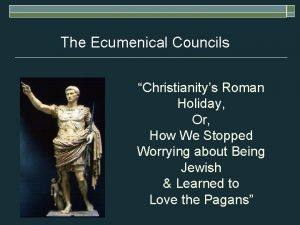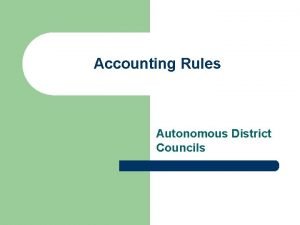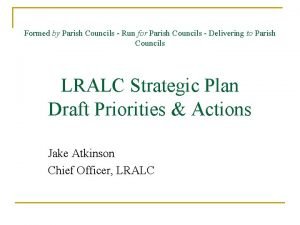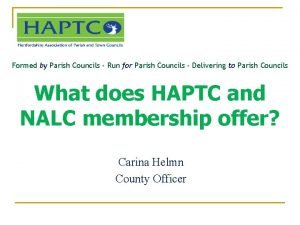The Seven Ecumenical Councils Lesson 12 The Seventh























- Slides: 23

The Seven Ecumenical Councils Lesson 12: The Seventh Ecumenical Council Nicaea II, 787

Background: Iconoclast Controversy

The Iconoclast Controversy • Ancient times – Images of Christ and the Saints were common (see catacombs) • Later in the Imperial Church – Concern over idolatry • 754 – Emperor Constantine V calls a Council at Hieria that forbade the use of images, ordered destruction • Why? • Islam’s influence • Monks vs. Emperors

The Iconoclast Controversy • “Iconoclasts” – Destroyers of Images • “Iconodules/Iconophiles” – Worshippers/Lovers of Images • Iconoclast Reasoning – Images either idolatrous or: • Nestorian: Divorcing the Divinity from the Humanity • Monophysite: Confusing Divinity and Humanity

The Iconoclast Controversy • Iconodule/Iconophile reasoning: • “Books for the illiterate” – teaching function • “Windows into heaven” – Aids to prayer • By early 8 th century, very common in the East, both in Churches and in private homes.

The Iconoclast Controversy • John of Damascus – Most influential theologian against iconoclasts: • “In former times, God, without body or form, could in no way be represented. • “But today, since God has appeared in the flesh and lived among men, I can represent what is visible in God.

The Iconoclast Controversy • “I do not venerate matter, but I venerate the creator of matter, who became matter for my sake, who assumed life in the flesh, and who, though matter accomplished my salvation. ” • “Latria” – Absolute worship, reserved only for God • “Proskynesis” or “Dulia” – reverence or veneration, may be offered to images as “sacramental channels” of “divine energies. ”

nd 2 Council of Nicaea, 787

Nicaea II, 787 • Called by Irene, widow of Emperior Leo IV, regent for their son and heir. • Originally held in Constantinople in 786, broken up by soldiers loyal to iconoclasts. • Moved to Nicaea in 787 after the soldiers were disbanded • Presided by Patriarch Tarasius of Constantinople • Pope Adrian I sent an archbishop and abbot to represent him. • Attended by 350 bishops

Nicaea II, 787 • Session 1: Several Bishops beg pardon for iconoclasm • Session 2: Pope Adrian’s letters are read, bishops receive • Session 3: More bishops received • Session 4: Proofs of images being lawful from Scripture and the Fathers are read and discussed • Session 5: blamed iconoclasm on Jews, Muslims, and Manicheans (Persian dualism)

Nicaea II, 787 • Session 6: Condemned pseudo-Seventh Council of Hieria, 754 • Session 7: Issued Declaration of Faith (see next slide) • Session 8: Moved to Constantinople at the Palace and was signed by Emperor and Regent Empress

Nicaea II, 787 • Declaration of Faith • “As the sacred and life-giving cross is everywhere set up as a symbol, so also should the images of Jesus Christ, the Virgin Mary, the holy angels, as well as those of the saints and other pious and holy men be embodied in the manufacture of sacred vessels, tapestries, vestments, etc. , and exhibited on the walls of churches, in the homes, and in all prototypes.

Nicaea II, 787 • “Therefore, it is proper to accord to them a fervent and referent adoration, not, however, the veritable worship which, according to our faith, belongs to the Divine Being alone – for the honor accorded to the image passes over to its prototype, and whoever venerate the image venerate in it the reality of what is there represented. ”

Outcome of the Council

Outcome of Nicaea II • In the East: • Closed out the Patristic Period • Solidified Eastern Theology • Solidified John of Damascus as one of the most important Eastern theologians • Made Icons the most visible aspect of Eastern worship • Celebrated on “Triumph of Orthodoxy” Sunday in October

Outcome of Nicaea II • In the West: • Pope approved and had the sessions translated into Latin • 794 Council of Frankfurt – Charlemagne rejected the Council • Libri Carolini – Systematic refutation of the document, later influenced the Protestants

Outcome of Nicaea II • Main issue: proskynesis was mistranslated as “adoration” which is better for latria. • I. e. , the Council seemed idolatrous • Also misunderstood/misrepresented some of what happened in the Council

Outcome of Nicaea II • Among Protestants/Anglicans: • In Book I of John Calvin’s Institutes of Christian Religion, this cause is taken up • Based on Libri Carolini • Probably had never known Eastern Christians • Rejects the distinction between veneration and adoration as “sophistry” • Doesn’t seem to have known John of Damascus or other Eastern Theologians on the issue

Outcome of Nicaea II • 2 nd Book of Homilies: “An Homily against the Peril of Idolatry” • Patently Iconoclast, based largely on Calvin, Western Synods that rejected Nicaea II, and similar misunderstandings • Long and tedious (about 300 pages)! • However, perfectly understandable in light of Medieval abuses

ACNA Catechism on Commandment nd 2

ACNA Catechism • 272. What is the Second Commandment? • The Second Commandment is: “You shall not make for yourself a carved image, or any likeness of anything that is in heaven above, or that is in the earth beneath, or that is in the water under the earth. You shall not bow down to them or serve them. ” • 273. What does the Second Commandment mean? • God’s people are neither to worship man-made images of God or of other gods, nor make such images for the purpose of worshiping them. (Deuteronomy 4: 15 -24)

ACNA Catechism • 276. Are all carved images wrong? • No. God, who forbids the making of idols and worship of images, commanded carvings and pictures for the Tabernacle. These represented neither God nor false gods, but rather angels, trees, and fruits from the Garden of Eden. (Exodus 37: 1 -9; 39: 22 -26; 1 Kings 6: 14 -19) • 277. Are idols always carved images? • No. Relationships, habits, aspirations, and ideologies can become idols in my mind if I look to them for salvation from misery, guilt, poverty, loneliness, or despair. (Ezekiel 14: 4 -5; Isaiah 2: 20; Ephesians 5: 2; 1 John 5: 21)

ACNA Catechism • 279. How will idolatry affect you? • If I worship idols I will become like them, empty and worthless, and alienated from God, the only One who can make me whole. (Psalm 115: 4 -8; Jeremiah 2: 11 -19; Romans 1: 18 -32) • 280. How can you love God in worship? • The Holy Scriptures teach me how to worship God, and the Church’s liturgy guides my worship in keeping with the Scriptures. I can show love to God by worshiping him in this way. (Romans 12: 1 -2; Hebrews 9: 11 -14; 10: 11 -25; 12: 18 -29; 13: 1 -19)
 Ecumenical advocacy alliance
Ecumenical advocacy alliance Fourth buddhism council filled by the emperor
Fourth buddhism council filled by the emperor Derbyshire association of local councils
Derbyshire association of local councils Sa councils
Sa councils Best practices of catholic pastoral and finance councils
Best practices of catholic pastoral and finance councils Features of indian council act 1861
Features of indian council act 1861 Customer councils
Customer councils Heavenly virtues and deadly sins
Heavenly virtues and deadly sins Madelyn hunter
Madelyn hunter Satan from the seventh grade
Satan from the seventh grade In the story, how is the seventh man characterized?
In the story, how is the seventh man characterized? You shall not steal commandment
You shall not steal commandment Nine rings of hell
Nine rings of hell Seventh-day adventist leadership structure
Seventh-day adventist leadership structure Seventh chord inversions
Seventh chord inversions Brave seventh grade viking warrior
Brave seventh grade viking warrior 3 layers of muscle
3 layers of muscle The seventh man
The seventh man Apostles creed articles
Apostles creed articles Mother and daughter character traits
Mother and daughter character traits Seventh normal form
Seventh normal form Hamlet seventh soliloquy
Hamlet seventh soliloquy Chords rule in dbms
Chords rule in dbms Kids classes in riverside seventh day baptist church
Kids classes in riverside seventh day baptist church

